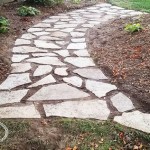Cost of Laying a Patio Per Square Metre: A Comprehensive Guide
The installation of a patio significantly enhances outdoor living spaces, providing an area for relaxation, entertainment, and dining. Understanding the cost involved in laying a patio per square metre is crucial for effective budgeting and project planning. This article will delve into the various factors influencing the overall cost, providing a detailed breakdown of expenses involved.
The price of laying a patio is subject to several variables, including the choice of materials, the size of the area, the complexity of the design, and the labour costs in the specific geographic location. Prior to initiating a patio project, it is imperative to conduct thorough research and obtain multiple quotes from reputable contractors to ensure a realistic assessment of the expenses.
Key Factors Influencing Patio Installation Costs
Numerous factors contribute to the overall cost of laying a patio. These include the material chosen, the size and complexity of the design, the existing site conditions, and labour expenses. A comprehensive understanding of these variables aids in accurate cost estimation.
1. Choice of Materials: The selection of paving materials directly impacts the overall cost. Options range from economical concrete slabs to premium natural stone like granite and sandstone. Each material possesses unique characteristics that influence both the aesthetic appeal and the price.
Concrete slabs are generally the most cost-effective option, typically ranging from £20 to £40 per square metre. These slabs are durable and require minimal maintenance, making them a popular choice for budget-conscious projects. However, concrete slabs may lack the aesthetic appeal of natural stone.
Block paving, made from individual clay or concrete blocks, offers a more decorative option. Costs typically range from £30 to £60 per square metre, depending on the block style and pattern. Block paving is highly versatile and can be arranged in various patterns to create a unique design.
Natural stone, such as sandstone, limestone, and granite, offers a premium aesthetic and superior durability. These materials are considerably more expensive, with prices ranging from £50 to £100 per square metre or more. The natural variations in colour and texture add a unique character to the patio, making it a sought-after choice for high-end projects.
Porcelain paving is a relatively newer option gaining popularity due to its durability, low maintenance, and aesthetic appeal. Prices for porcelain paving typically range from £40 to £80 per square metre. Porcelain is resistant to staining, fading, and frost damage, making it an excellent choice for outdoor applications.
Gravel and loose aggregates provide a more rustic and informal patio option. These materials are relatively inexpensive, generally costing between £10 and £30 per square metre. However, gravel patios require more maintenance to prevent weed growth and maintain a level surface.
2. Size and Complexity of Design: The area of the patio directly correlates with the overall material cost. Larger patios require more materials, increasing the total expense. The complexity of the design also plays a significant role. Intricate patterns, curves, and custom cuts demand more labour and potentially more material waste, impacting the cost.
Simple rectangular or square patios are typically the most cost-effective to install, as they require minimal cutting and fitting. More complex designs with curves, angles, or multiple levels necessitate additional labour and expertise, thus increasing the cost per square metre.
Consider the addition of features such as steps, retaining walls, or built-in seating areas. These enhancements add to the complexity and overall cost of the project. Incorporating drainage solutions or dealing with uneven ground can also increase labour and material expenses.
3. Existing Site Conditions and Preparation: The condition of the existing site is a crucial factor in determining the overall cost of laying a patio. Uneven ground, existing structures, and drainage issues can significantly impact the preparation work required.
Clearing the site, removing existing vegetation, and excavating the area to the correct depth are essential steps in preparing the base for the patio. These tasks can be time-consuming and labour-intensive, especially if the site is heavily overgrown or contains large tree roots.
Levelling the ground and creating a stable sub-base is critical for the longevity of the patio. This often involves importing and compacting hardcore or gravel to provide a solid foundation. The cost of these materials and the associated labour can add significantly to the overall project expenses.
Addressing drainage issues is vital to prevent water damage and ensure the patio remains stable. Installing drainage systems, such as French drains or soakaways, may be necessary, particularly in areas with poor drainage. These additions will contribute to the final cost.
4. Labour Costs: Labour costs constitute a significant portion of the total patio installation expense. Rates vary depending on the geographic location, the contractor's experience, and the complexity of the project. It is prudent to obtain quotes from several contractors to compare pricing and services.
Labour costs typically range from £30 to £60 per square metre, but this can fluctuate based on the factors mentioned above. Simpler installations with readily available materials may command lower labour rates, while complex projects with intricate designs and challenging site conditions will likely incur higher charges.
Ensure that the contractor provides a detailed breakdown of labour costs, including site preparation, excavation, base preparation, paving installation, and finishing work. A clear understanding of the labour charges helps to avoid unexpected expenses and disputes.
It is also important to verify that the contractor is licensed, insured, and has a proven track record of successful patio installations. Hiring a reputable contractor ensures a high-quality installation and reduces the risk of costly mistakes.
Detailed Cost Breakdown: Materials, Labour, and Other Expenses
A comprehensive understanding of the cost components involved in laying a patio per square metre is essential for accurate budgeting. This section provides a detailed breakdown of material costs, labour expenses, and other potential costs.
Material Costs: The cost of paving materials is the most significant expense. As discussed earlier, the price varies widely depending on the chosen material. Concrete slabs typically range from £20 to £40 per square metre, while natural stone can cost £50 to £100 or more per square metre. Block paving and porcelain paving fall within the £30 to £80 per square metre range.
In addition to the paving materials, consider the cost of other essential materials such as hardcore, sand, cement, and grout. Hardcore, used for the sub-base, typically costs around £20 to £40 per tonne. Sharp sand, needed for the bedding layer, ranges from £30 to £50 per tonne. Cement, used for mixing mortar, costs approximately £8 to £12 per bag. Grout, used to fill the joints between paving stones, varies in price depending on the type and colour.
Labour Costs: Labour costs represent a substantial portion of the overall expense. Site preparation, excavation, base preparation, paving installation, and finishing work all contribute to the labour charges. As mentioned, labour costs typically range from £30 to £60 per square metre but can vary based on the complexity of the project and the contractor's rates.
The complexity of the design, the site conditions, and the availability of the contractor influence labour expenses. Intricate patterns, slopes, and difficult access can increase labour costs. Ensure that the contractor provides a detailed breakdown of the labour charges to avoid surprises.
Other Expenses: Beyond materials and labour, other expenses may arise during the patio installation process. These include skip hire for waste removal, tool rental, permit fees, and contingency funds for unforeseen issues.
Skip hire costs typically range from £150 to £300, depending on the size of the skip and the duration of the hire. Tool rental may be necessary if specialized equipment is required, such as a plate compactor or a concrete cutter. Permit fees may apply if the patio installation requires planning permission or building regulations approval.
It is crucial to allocate a contingency fund to cover unforeseen issues such as unexpected ground conditions, drainage problems, or material shortages. A contingency fund of 5% to 10% of the total budget is generally recommended.
Estimating The Cost of a Patio Project: A Practical Approach
Estimating the cost involves a systematic approach, considering all variables. This section outlines practical steps for accurately estimating the cost of a patio.
1. Measure the Area: Accurately measure the length and width of the intended patio area. Multiply these values to determine the total square metreage. This measurement forms the basis for calculating material and labour costs.
2. Choose Materials: Select the desired paving materials, and research the cost per square metre from local suppliers. Factor in the additional materials required, such as hardcore, sand, cement, and grout. Obtain quotes from multiple suppliers to compare pricing.
3. Obtain Quotes from Contractors: Contact several reputable contractors and request detailed quotes for the patio installation. Provide them with the dimensions of the area, your material preferences, and any specific design requests. Ensure that the quotes include a breakdown of labour costs, site preparation charges, and any other potential expenses.
4. Assess Site Conditions: Evaluate the existing site conditions. Identify any potential challenges such as uneven ground, drainage issues, or existing structures that may require removal or modification. Factor in the costs associated with addressing these issues.
5. Calculate Total Cost: Sum the material costs, labour expenses, and other potential costs, including skip hire, tool rental, permit fees, and contingency funds. This calculation provides an estimate for the project.
6. Review and Refine: Compare the estimated cost with the available budget. Adjust material choices, design elements, or contractor selection as needed to align the project with the budget. It's crucial to balance aesthetic preferences with practical considerations.
By following these steps, one can develop a realistic estimation for a patio installation project, which enables informed decision-making and proficient budget control.

How Much Does A New Patio Cost In 2024 Checkatrade

New Patio Cost Guide 2024 Of Laying A

New Patio Cost Guide 2024 Of Laying A

New Patio Cost Guide 2024 Of Laying A

How Much Does A Patio Cost Installation 2024 Landscaping Network

2024 Patio Cost To Build And Install Angi

How Much To Lay A Patio Installation Cost Guide

How Much Does It Cost To Build A Patio In 2024 Forbes Home

Patio Laying Cost List Free Quotes 2024

How Much Does A New Patio Cost In 2024 Checkatrade
Related Posts








